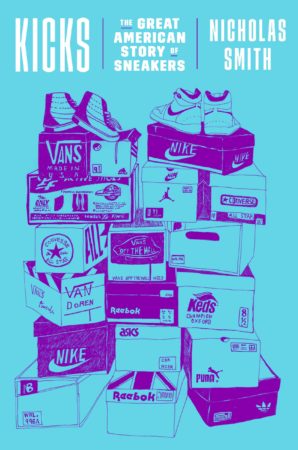
Nicholas Smith
A former Kearny resident has written a book which is getting good reviews. The book, titled Kicks: The Great American Story of Sneakers, is about the cultural history of sneakers, tracing its influence and impact on sports, business, pop culture and American identity. The book’s author is Nicholas Smith. He is a freelance journalist, writer and now a published author. Kicks is published by Crown, an imprint of Penguin Random House and went on sale on May 1, 2018.

Kicks
Kicks covers over 150 years of sneaker history from its early beginnings as beach wear and “croquet sandals” to the 20-billion-dollar industry it is today. Along the way, you will learn interesting facts and read entertaining stories such as how Jane Fonda and the aerobics craze of the 1980s tapped into the underserved female market and spurred sales; how two feuding German brothers founded Adidas and Puma among the 1936 Olympics and American runner Jesse Owens historic victories, and their feud’s impact on the business of sports; how Nike and Michael Jordan hooked up and developed the Air Jordan; and the rise of Hip-Hop and its influence in elevating sneakers to street wear, style and status symbols epitomized by the Run DMC song “My Adidas.”
Some of the advance reviews of the book include:
Booklist – “No background (or interest, even) in footwear is required to enjoy this entertaining read…Readers of sports history, popular culture, and business will be fascinated by Smith’s exciting, informative, and multifaceted narrative of the major roles the sneaker has played in U.S. branding, perceptions and culture.”
Kirkus – “Smith follows his fascination, sprinting through the evolution of the planet’s hippest, most popular footwear, a history that goes well beyond sports and into the streets of youth culture…A cornucopia of factoids and fun asides bursting with a wealth of in-depth information on every aspect of sneakers, from their birth to their current and continuing explosive popularity.
Nicholas Smith grew up in Kearny, Arizona. He is a 2001 graduate of Ray High School where he played trombone in the band for four years and competed on the track and field team for the Bearcats. Nicholas said that his 8th grade English teacher, Jennifer Kinnard, was an early influence on him.
“Her class included a fair bit of creative writing along with interesting reading assignments that really developed an early interest in writing for me,” he said.
Following high school, Nicholas attended the University of Arizona.
“I didn’t have much of an interest in journalism until college, when I happened to take a sociology class at the U of A that required us to go out and talk to students involved in social demonstrations around campus,” he said. “I found I liked talking to people and writing down what they said and then took a few journalism classes to feed that interest. One thing led to another, which led to another, which led to the book.”
Nicholas earned a Bachelor of Arts degree in journalism and a B.A. in business administration at the University of Arizona. He is a graduate of Columbia Journalism School and received his masters of science degree in journalism. He is a 2014 Lynton Book Writing Fellow from Columbia University. He has worked at the Earth Institute at Columbia University as a research assistant for the science news site GlacierHub.org.
He has won a number of journalism awards including a first place in the community reporting category from the Arizona Press Club and contributed to the Tucson Weekly’s first place award for best blog initiative from the Suburban Newspaper Association. His work has appeared in Esquire, GlobalPost, the Vienna Review and Tucson Weekly. One of the more interesting articles written by Nicholas was about Austrian museums.
“One article that jumps out,” he said, “was about how state-owned Austrian museums are combing through their collections to make sure that everything they have in their collections, whether it is a famous painting or a common candlestick, was not looted during World War II. This meticulous process has taken some museums decades and often involves a bit of luck to determine who the rightful owner is.”
Nicholas currently lives in Vienna, Austria with his wife and two children.
“A couple of years after my wife (who is Austrian) and I got married, we got bored living in Tucson and decided to move to Vienna,” he explained. “For her it was a chance to return to where she grew up and for me it was a chance to live somewhere completely different from Arizona. I currently write full time for a living (though not exclusively books of course).”
Nick was asked why he chose sneakers as a subject for his book. He responded: “Why not write about sneakers? They are one of those things that has a rich, hidden history that influence (and were influenced by) so many different areas of modern culture, including fashion, business, advertising, music, and of course, the development of sports itself. With this book, I was interested in using sneakers as a lens to explore the development of these different areas. One hundred fifty years ago, sneakers were little more than cheap canvas and rubber shoes that were used and discarded as beach shoes. Today, athletic shoes are a nearly $20 billion business in the U.S. alone. For some people, limited-edition sneakers costing thousands of dollars are something to collect while for others, they are the default shoe we throw on when going to the supermarket. The book is about how we got from there to here.”
Nick shared some interesting things he learned in his research.
“Two things jump out: First is the story of Bill Bowerman, who was the University of Oregon track coach in the 1950s and 60s. Bowerman was so obsessed with having his runners go as quickly as possible that he experimented with lighter running clothes, mixed his own rubber for running surfaces in his backyard, and even handmade individual shoes for his runners, thinking that a person will run the fastest in shoes specifically made for them. Bowerman also co-founded Nike with Phil Knight, one of his former athletes, and was also credited with helping start the jogging boom of the 70s.”
Nick continued: “The second interesting thing is the sneaker-shaped coffin. In parts of Ghana, it is typical for the style of coffin to reflect the personal identity of the deceased. These custom-made coffins have come in the shape of airplanes, cell phones and even a Nike sneaker (there’s a picture in the book of the one the Brooklyn Museum in New York has in its collection). I think it really speaks to the sneakers’ global appeal.”
Nick is a runner and talked about his personal choice of sneakers.
“Right now, my favorite is an orange and blue pair of Nike Internationalists, a throwback to the brand’s running shoes of the 70s and is notable for being available in many different color combinations. As for running shoes, I have been wearing Brooks for nearly 10 years, though not the same pair of course!”
As part of the interview, Nick was asked what advice would you give an aspiring writer from a small town that wants to write a book or go into journalism?
He said “Whether you’re from a small town or a big city, I think the most important thing for any writer is to be curious. You never know when you’ll find the thing that will fuel an entire book. Initially I didn’t find sneakers interesting, but the more I learned about them, the more I found I just had to write about them. Another piece of advice is any large undertaking is a series of small undertakings. Even if you only write one paragraph a day, if you keep doing that eventually you’ll have a book.”
Kicks is available at Barnes and Noble, Amazon, and CrownPublishing.com, to name a few outlets. It is available in hardback and e-book format. Look for it in your favorite bookstore or online.
Congratulations, Nick on having Kicks published!

